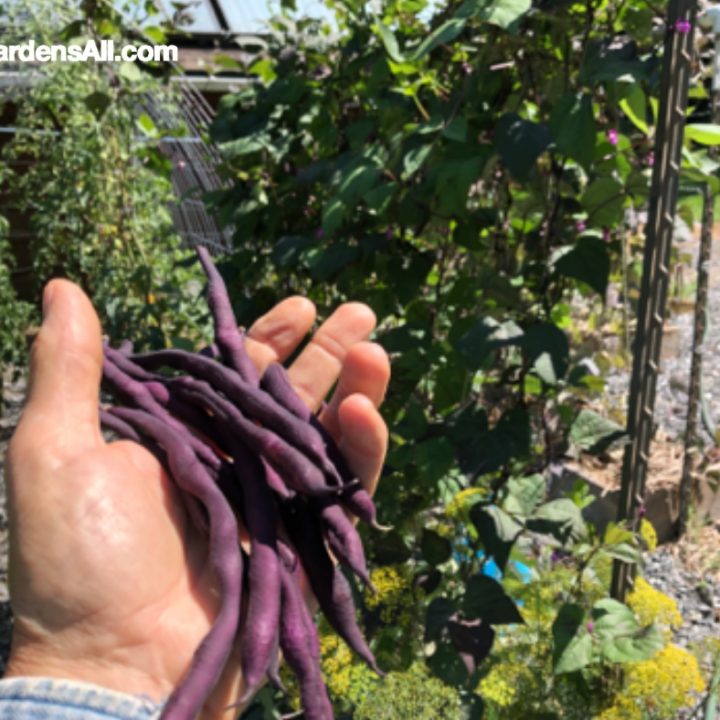Snap Beans in All Sizes and Colors – We Love ’em All!
When it comes to how to grow beans in style, we’re talking about experimenting with different colors and varieties and also growing methods. Further, growing methods, such as options in bean trellising can add beauty, style and functionality to any garden or yard landscape.
Snap Beans, Green Beans and String Beans and All
The term ‘Green beans’ is often the generic and interchangeable with snap beans, string beans, wax beans and pole beans. There’s little difference between beans, especially when it comes to how to grow beans, and for use in recipes. The subtle variables include that some are sweeter and more tender, mainly in color and shape, separate one type from another, and some have strings that need to be removed and others are stringless.
Beans are wonderful… we love them all, but often we think of beans mostly in terms of food. However, beans are not only great food but also add beauty to the garden, and to the plate.
In fact, if you’re a yard gardener looking to grow more attractive edible plants in your yard, consider some of the purple, red or golden pole beans, or the exotic dragon’s tongue beans.
You can read about attractive yard garden plants that most Home Owner Associations (HOAs) won’t mind in this other article. Next, we’re sharing a snippet on a great find we’ve been growing.
Bean Leaves Are Also Edible
Another wonderful benefit to growing beans is that bean leaves are edible and nutritious. Since bean leaves are usually abundant, you can harvest them all season, snipping the young ones to add to fresh green salads and the more mature ones for cooking in much the way you would cook spinach or chard.
The More You Take, the More They Give
Once your beans reach a good size for harvesting, go ahead and start collecting some each day, even if it seems like a small harvest at first. Harvesting beans encourages new growth so you’re actually increasing your bean yield with each harvest.
Harvesting beans encourages growth, so If you want more beans, pick more beans!
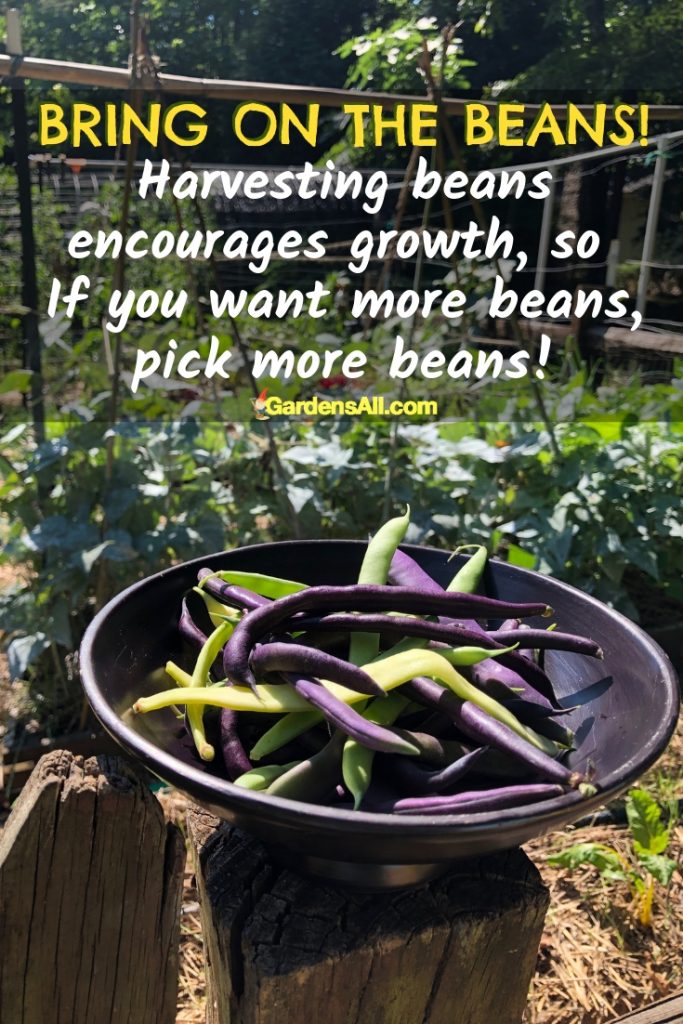
Types of Beans
Pole Beans – AKA Vining Beans
- Pole beans are vining beans that need supports and take 55-65 days to reach maturity.
- Can produce for 1-2 months
Bush Beans
- Bush beans are shorter bushier plants that do not require supports and take 50-55 days to reach maturity
- Production is most active for about 2 weeks, so plan on multiple crops of bush beans.
Some Best Bean Varieties
We are growing several varieties of pole beans (‘Carninat’ and ‘Marie’s Gold Vining’ ) and a selection of bush beans (Purple Teepee, Black Coco, and Romano Purpiat). All but the late-planted Carminat are producing nicely.
The purple and gold (yellow) colored beans are easier to harvest because they’re easier to spot amidst the green foliage. Also, we’ve found that growing on a bamboo bean teepee or cattle panel trellis for vertical gardening makes it easier to see and pick the beans.
Another favorite bean we grow each year are the purple pole beans.
Gold Marie Vining Beans – Brought Back From the Brink of Extinction
These are one of the beans we’re growing in a container with a teepee support.
We were excited to learn of the Gold Marie vining beans. We planted our seeds in mid May in NC zone 7a. Our first harvest was approximately six weeks later in June.
We’re love these bright, beautiful and delicious Gold Marie Vining beans and they’re now on our annual list of beans to grow. The only warning is the same as for most fresh beans: if you let them grow too long they’ll be tough and stringy. But if that happens you can save them for seeds or shell them and cook the inner beans.
It turns out that the Gold Marie Vining beans were nearly extinct until recently. Thanks to the efforts of backyard gardeners and veteran seed savers, these beauties are making a comeback!
Beans can get too fibrous and tough if allowed to grow too big.
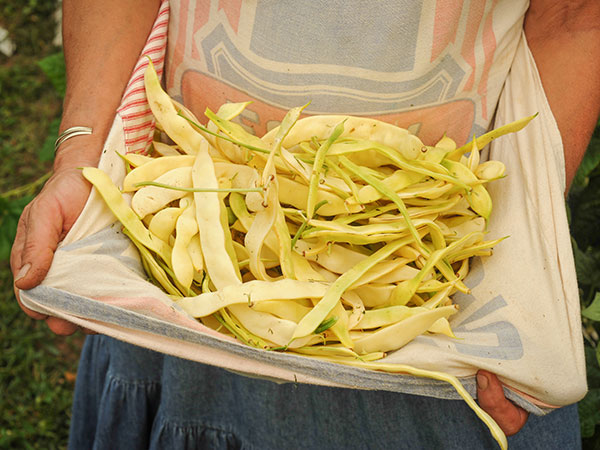
Where to Buy Gold Marie Vining Beans
- The Living Seed Company – where we purchased our seeds
- Bakers Creek – RareSeeds.com – always a good experience
- Oikos Tree Crops
- Sustainable Seed Co.
Above are a few seed companies that have Gold Marie listed. However, there are likely others, so here is a list of garden seed companies.
NOTE: especially given Covid-19 setbacks, some companies may be out of stock. We suggest you contact them and ask when they expect to be back in stock and then keep checking back.
Gold Marie Vining Beans – Plant Description
- Color: golden-yellow
- Bean: 6″-7″ flattened pods remain tender and juicy even when large
- Benefits: Ornamental
- Preparation – Like snap beans:
- raw – for snacks and salads
- steamed, braised, sautéed
- add to casseroles, soups, stir fries and other vegetable dishes
- pickled – mix with green and purple beans for wonderful colorful effect (
NOTE: Although the purple beans lose color when cooked, not sure about pickling as we haven’t done that yet)
How to Grow Beans
- Sow beans –
- directly in garden bed when soil temp reaches 70-90℉
- plant every 2-3 weeks for harvesting throughout the season
- Seed Spacing – 1-1.5″ deep x 1-3″
- Plant Spacing – 3-6″ apart
- Soil – loose, fertile and well drained
- Sun – full sun
- Size – 6′ – 8′ vine
- Water – keep moist, do not over water
- Mulch – around plant base to reduce weeds – (we favor wood chips)
- Harvest –
- 55-65 days
- pick pods at 6″- 9″
- after dew has dried
- harvest frequently to stimulate new growth
Harvesting Beans
As with many plants, removing the “fruit” or expended flower encourages more production. So pick beans daily and you’ll have more to harvest over time.
In zone 7a we begin harvesting beans in late June, and they produce for about 4 weeks.
For Maximum Bean Production – Stagger Plantings for Continuous Harvest
Since the window of bean production is only 2-4 weeks with the bulk of production being in weeks 2 & 3, it’s a great idea to plant new crops of beans every two weeks. Keep in mind that it takes 55-65 days to harvest, so depending on your zone, if you start early you can keep production going up to the first freeze.
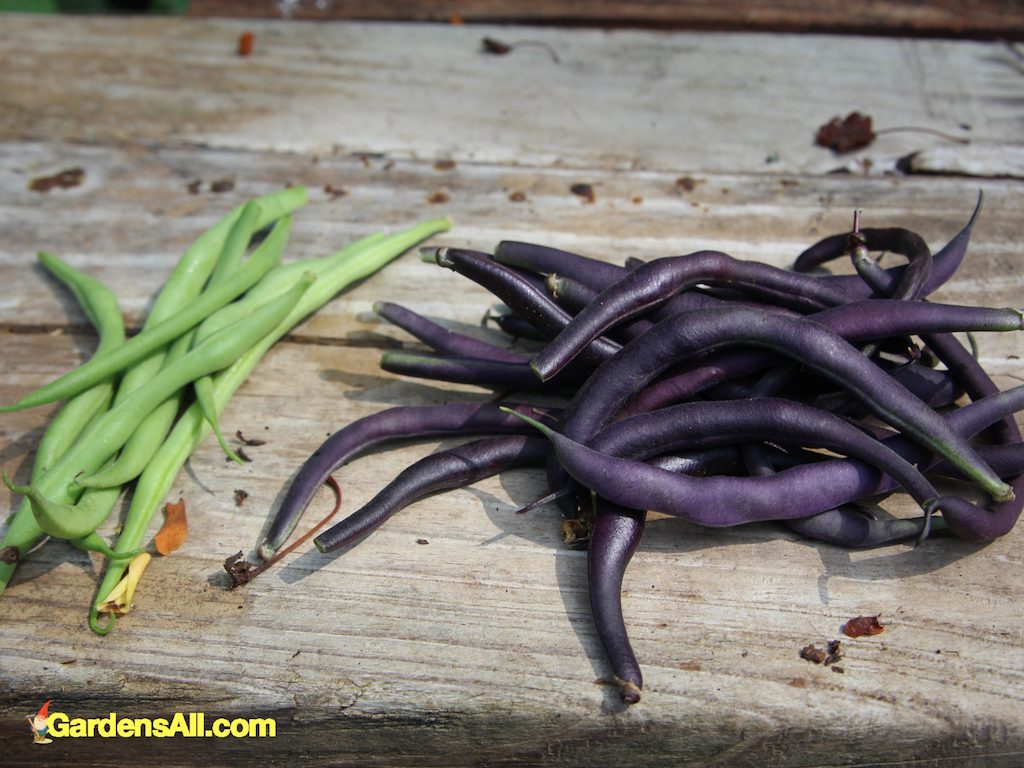
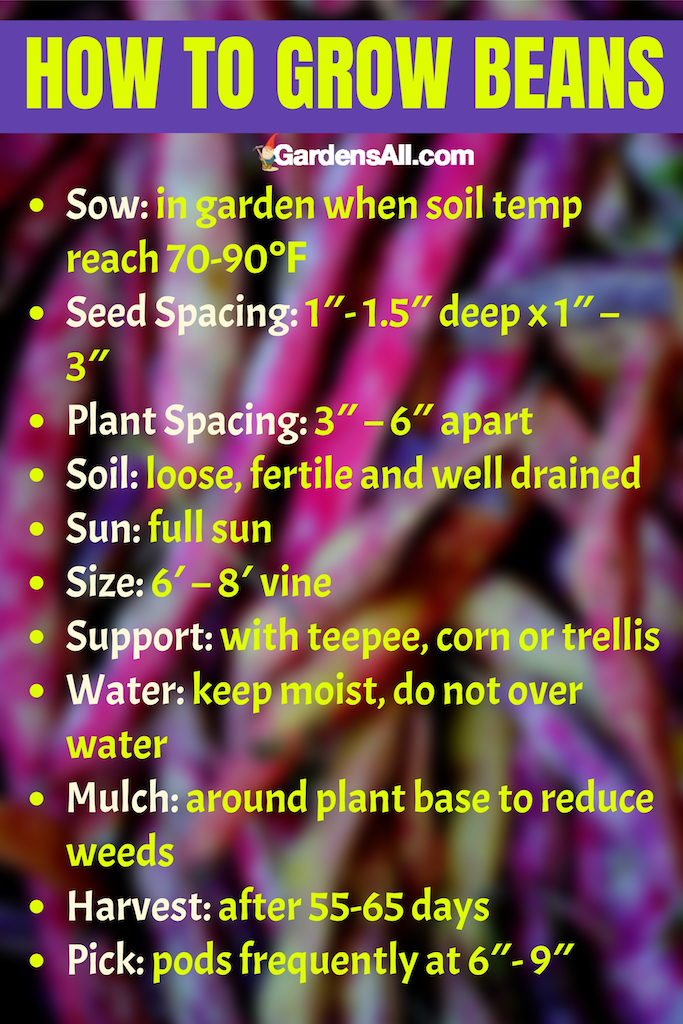
Here’s info on how to create a bamboo teepee trellis for growing beans in containers or garden beds.
Bean Trellises, Supports and Teepees
Teepees offer great support for all kinds of growing needs. We’re using them for vining, pole and bush beans.
We have a small grove of bamboo that we’ve been growing for YEARS, and we use it for so many things in the garden.
And yes… it can spread, though ours has been reasonable so far. It was planted around 25 years ago and only now are we beginning to see bamboo sprouts here and there in other nearby areas of our property.
So we may still awake one day to realize we’re in a bamboo crises, where it’s taking over everything, but so far, so good. Meanwhile, it’s a free source of ready supports for teepees, cages, tomato supports, garden fencing, plant measuring sticks and more.
We love the idea of growing a crop that can be used as garden tools!
A Cattle Panel Trellis for Pole Beans
Wishing you great gardens and happy harvests!
I’m LeAura Alderson, a garden, herb and plant enthusiast with a passion for discovering the many edible and medicinal benefits of the plants all around us, including the weeds! I’m a writer, editor and media publisher for our family of websites.
While I was certified in fitness and life coaching, I am NOT a health practitioner. However, I’m a lifelong health enthusiast, with a keen interest in healthy, organic foods and making home remedies and the content we share is from our own experience and usage as well as that extracted from scientific research so that you can explore further on your own.
Always seek the advice and guidance of your health practitioners first and foremost.
As a family we’re steadily expanding our gardening, experimentation and knowledge around all things gardening, edible landscaping, fresh organic foods and self sustainability with farming in our future. I also own and manage iCreateDaily.com, a site all about transformation through creation, and the power of positivity, optimism and mindset.

